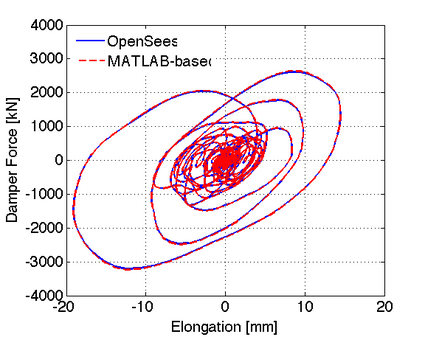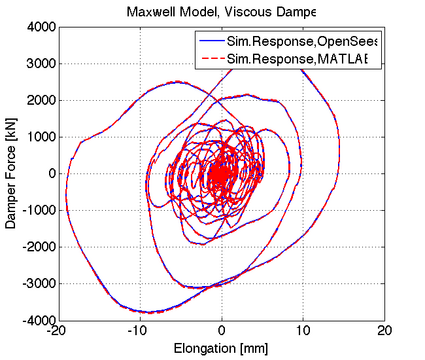Maxwell Material: Difference between revisions
Jump to navigation
Jump to search
No edit summary |
No edit summary |
||
| Line 1: | Line 1: | ||
{{CommandManualMenu}} | {{CommandManualMenu}} | ||
This command is used to construct a Maxwell | This command is used to construct a ViscousDamper material, which represents the Maxwell Model (linear spring and nonlinear dashpot in series). The Maxwell material simulates the hysteretic response of viscous dampers. | ||
{| | {| | ||
| style="background:yellow; color:black; width:800px" | '''uniaxialMaterial | | style="background:yellow; color:black; width:800px" | '''uniaxialMaterial ViscousDamper $matTag $K $Cd $alpha''' | ||
|} | |} | ||
| Line 12: | Line 12: | ||
| style="width:150px" | '''$matTag ''' || integer tag identifying material | | style="width:150px" | '''$matTag ''' || integer tag identifying material | ||
|- | |- | ||
| '''$K ''' || Elastic stiffness of linear spring (to model | | '''$K ''' || Elastic stiffness of linear spring (to model the axial flexibility of a viscous damper (brace and damper portion) | ||
|- | |- | ||
| '''$ | | '''$Cd ''' || Viscous parameter of damper | ||
|- | |- | ||
| '''$ | | '''$alpha ''' || Viscous damper exponent | ||
|- | |- | ||
|} | |} | ||
| Line 29: | Line 27: | ||
| '''''1. Input parameters:''''' | | '''''1. Input parameters:''''' | ||
|- | |- | ||
| Assume a viscous damper with axial stiffness K= | | Assume a viscous damper with axial stiffness K=300.0kN/mm, viscous parameter Cd=280.3kN(s/mm)<sup>0.3, and exponent a=0.30. | ||
|- | |- | ||
| The input parameters for the material should be as follows: | | The input parameters for the material should be as follows: | ||
| Line 35: | Line 33: | ||
|- | |- | ||
|- | |- | ||
| uniaxialMaterial | | uniaxialMaterial ViscousDamper 1 300 280.3 0.30 | ||
|- | |- | ||
|- | |- | ||
| Using these properties | | Using these properties, Figure 1 shows the hysteretic response of this damper for sinusoidal displacement increments of 12, 24 and 36mm and a frequency f = 0.5Hz. | ||
|- | |- | ||
|The sensitivity of the viscous damper with respect to its axial stiffness is shown in | |The sensitivity of the viscous damper with respect to its axial stiffness is shown in Figures 2 to 5 for the following set of parameters: | ||
|- | |- | ||
| [[File:Fig1.png|425px|thumb|left|Figure 1. Viscous Damper with K= | | [[File:Fig1.png|425px|thumb|left|Figure 1. Viscous Damper with K=300.0 kN/mm, Cd=73.0kN(s/mm)<sup>0.6</sup>, a=0.60]] , [[File:Fig2.png|425px|thumb|left|Figure 2. Viscous Damper with K=300.0 kN/mm, Cd=12.0kN(s/mm)<sup>1.0</sup>, a=1.0]] | ||
|- | |- | ||
| [[File:Fig2.png|425px|thumb|left|Figure 2. Viscous Damper with K= | | [[File:Fig1.png|425px|thumb|left|Figure 2. Viscous Damper with K=300.0 kN/mm, Cd=683.0kN(s/mm)<sup>0.1</sup>, a=0.1]] , [[File:Fig2.png|425px|thumb|left|Figure 2. Viscous Damper with K=300.0 kN/mm, Cd=1017.7kN(s/mm)<sup>0.01</sup>, a=0.01]] | ||
|- | |- | ||
|- | |- | ||
| Line 62: | Line 60: | ||
|- | |- | ||
|} | |} | ||
Code Developed by : <span style="color:blue"> by | Code Developed by : <span style="color:blue"> Prof. Kazuhiko Kasai and implemented by Sarven Akcelyan & Prof. Dimitrios G. Lignos, (McGill University) </span> | ||
Revision as of 18:12, 21 August 2013
- Command_Manual
- Tcl Commands
- Modeling_Commands
- model
- uniaxialMaterial
- ndMaterial
- frictionModel
- section
- geometricTransf
- element
- node
- sp commands
- mp commands
- timeSeries
- pattern
- mass
- block commands
- region
- rayleigh
- Analysis Commands
- Output Commands
- Misc Commands
- DataBase Commands
This command is used to construct a ViscousDamper material, which represents the Maxwell Model (linear spring and nonlinear dashpot in series). The Maxwell material simulates the hysteretic response of viscous dampers.
| uniaxialMaterial ViscousDamper $matTag $K $Cd $alpha |
| $matTag | integer tag identifying material |
| $K | Elastic stiffness of linear spring (to model the axial flexibility of a viscous damper (brace and damper portion) |
| $Cd | Viscous parameter of damper |
| $alpha | Viscous damper exponent |
Examples:
| 1. Input parameters: |
| Assume a viscous damper with axial stiffness K=300.0kN/mm, viscous parameter Cd=280.3kN(s/mm)0.3, and exponent a=0.30. |
| The input parameters for the material should be as follows: |
| uniaxialMaterial ViscousDamper 1 300 280.3 0.30 |
| Using these properties, Figure 1 shows the hysteretic response of this damper for sinusoidal displacement increments of 12, 24 and 36mm and a frequency f = 0.5Hz. |
| The sensitivity of the viscous damper with respect to its axial stiffness is shown in Figures 2 to 5 for the following set of parameters: |
  |
  |
| 2. Tcl input file for Viscous Damper Calibration. |
| 3. OpenSees Example of 1-story steel moment frame with a viscous damper: (to be posted) |
References:
| [1] | Olsson, A.K., and Austrell, P-E., (2001), "A fitting procedure for viscoelastic-elastoplastic material models," Proceedings of the Second European Conference on Constitutive Models for Rubber, Germany, 2001. |
| [2] | Ottosen, N.S., and Ristinmaa, M., (1999). "The mechanics of constitutive modelling, (Numerical and thermodynamical topics)," Lund University,Division of Solid Mechanics, Sweden, 1999. |
Code Developed by : Prof. Kazuhiko Kasai and implemented by Sarven Akcelyan & Prof. Dimitrios G. Lignos, (McGill University)